Millions of tourists travel to Egypt each year. The reasons for taking a trip to Egypt are certainly wide-ranging, but there is an obvious attraction whose popularity rises above the rest – the Pyramids of Giza.
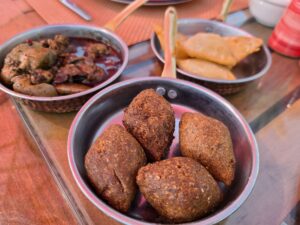
Following the Pyramids in popularity are sites like the Sphinx, the Egyptian Museum, the Valley of the Kings and Luxor Temple. I could continue, but the point is clear: the biggest draw of tourism in Egypt, by far, is what remains of the great Ancient Egyptian civilization.
Ancient Egypt is an interesting subject, one that I now find even more interesting than prior to visiting the country. The temples, tombs, mummies – these are great reasons to visit Egypt.
But there are other reasons, too.
Namely, the Nile River is fascinating. Cairo is an historic megacity. The Red Sea is stunning.
What about the food? Do people visit Egypt for the food?
To be frank, I have not heard of anyone going all the way to Egypt for the food. I mean, let’s not kid ourselves. Egypt isn’t a culinary destination like Italy, France or Thailand – and that’s okay! Being famous for something other than food doesn’t automatically mean the food is bad… Right?
Rest easy. Egyptian food is indeed pretty good.
I had minimal expectations about eating in Egypt. I absolutely hoped that the food would be good, but I didn’t know enough to make many assumptions. There was only one way to find out.
What is Egyptian Food? Is it good? Expensive? Safe to eat? I’ve done some of the “research” for you, so let’s dig into Egyptian food.
What is Egyptian Food?
To over-generalize the cuisine of Egypt, it can be said that it has similarities and elements of cuisine found across the Arab world, the Maghreb and Mediterranean region. The Nile River plays an important part in agriculture but less as a direct food source. Along the Red Sea and Mediterranean Sea coasts, seafood obviously has a larger presence than the interior portions of the country.
Staple Dishes & ‘Must-try’ Eats in Cairo
Egyptian cuisine has a lot to offer, and Cairo is a massive place with thousands upon thousands of restaurants, cafes and food stalls. My research was fairly extensive (and tasty), but there is far more beyond this summary. This should give you a good idea about what you can look for and where to start your journey eating in Cairo.
Bread
Bread is the most important part of the Egyptian diet. Bread and grain is the primary staple of many diets, and this was especially true from an historical perspective. Even in modern Cairo, eating anything from snacks to large meals revolves around bread. When you walk the streets of Downtown Cairo, you will come across huge mounds of fresh-baked bread for sale on the sidewalks.

Bread is so important in Egypt that it is subsidized by the government. Tens of millions of Egyptians have their bread subsidized to the tune of billions of dollars annually. While this is partially to help poorer citizens, it’s also a cultural expectation. Governments in Egypt have been providing the citizens bread for a long, long time.
In Cairo, bread is equally important. And there is the added big city bonus, meaning it is plentiful and widely available.
Baladi – Street Bread of Cairo
The primary bread eaten in Egypt is aish baladi, typically just called ‘baladi.’ The closest thing I can compare baladi to is pita. It is a flatbread that puffs up when it’s fresh and slowly deflates to a more dense, finished product.
What I love the most about this bread is that I found it for sale on sidewalks all around Cairo. Freshly-baked bread sold on the side of the road – that’s just something I have not (and, likely, will not) ever experience at home. The interruption of big city smells by fresh bread is a nice treat.

Another reason to appreciate baladi is the price. You can get several chunks of flatbread for pennies. It’s filling, too. The final reason I enjoy this Egyptian favorite is that you can eat it with anything. Jam, cheese, tahini – it works for any of these. My apologies to Egyptians if this is not the norm, but it worked well for me.
Bataw
Bataw is another flatbread that is an important part of Egyptian cuisine. Bataw is thinner than baladi, and is an excellent choice to snack with other foods. I most frequently encountered bataw for breakfast in hotels, usually with cheese. My preference was, again, with jam, but this particular bread is a cheap and easy choice to snack on throughout the day.
Feteer
This one is something else. I don’t know what the Egyptians do to get this just right, but Feteer is now one of my favorite breads in the world.
It’s flaky, layered and buttery with a subtle sweetness. Feteer is similar to filo bread, but it’s better than any filo I’ve ever had. Feteer can be sweet or not, and sometimes it is even filled with cheese, meats, spices or sugar. My preference is for the savory variety, but I’ll take it any way it is offered. Hands down, feteer is one of the best breads in the world.
Koshari
While bread is the most important part of Egyptian cuisine, it isn’t the most exciting. For that, we turn to some of the more interesting parts of eating in Cairo.
The best place to start is Koshari, the national dish of Egypt. No breakdown of eating in Cairo is complete without mentioning this interesting dish. And no trip to Egypt has the full experience without trying it once or twice.
What is koshari?
That’s not easy to sum up concisely. Koshari is a strange mix of foods all together in one. Honestly, it kind of seems like it was created by a toddler throwing all of his favorite foods into the same bowl. There is no disrespect intended here. It’s just a strange combination of food, a little bit of everything, seemingly at random.

Koshari generally consists of chickpeas, rice, pasta, noodles, lentils and crispy onions, with a little bit of tomato sauce. Garlic vinegar is a popular addition, and I was served this with a citrus fruit more than once. To me, it looked like a lime. However, I was told it was a lemon, and it did indeed turn out to taste like a lemon.
It’s easy to see why I find this to be a particularly odd combination of food. It is an odd mix of ingredients. And no two places make it the same, so that’s a fun game to play.
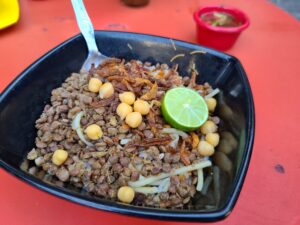
The important thing is that koshari is good. The flavors are spot on, and I highly recommend adding the garlic vinegar, a squirt of lemon and even a dash of hot sauce.
Koshari is one of those foods that likely arises out of necessity. Times were tough, options limited. Meat was probably too expensive and out of the question. So they used what they had, put it all together, and it has been fine-tuned over the centuries.
The mish-mash bowl of everything isn’t complex. It’s really tasty, though. You can find it at cafes or on the street. Koshari is still popular as an affordable option, so it should be cheap for you, too.
Falafel
Did you know that falafel originated in Egypt? In fact, according to an Egyptologist to whom we spoke, there is an ancient recipe for falafel found in hieroglyphics. The source is often where you find the best version of any particular food. And with archaeological evidence going back thousands of years, you know it’s going to be authentic.
Better yet, Egyptian falafel is, by far, the best I’ve ever had. Prior to visiting Egypt, my falafel knowledge was extremely limited. I’d eaten it many times, but it didn’t stand out.
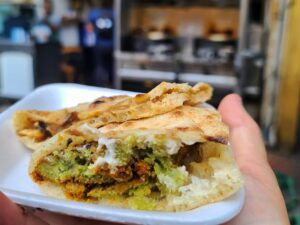
This changed in Cairo. My first taste of Egyptian falafel was a game changer and set the standard for all others. According to locals, true falafel is made from fava beans – not chickpeas. Perhaps this is the key difference. I like think it also has to do with the previously-mentioned ancientness of the popular snack in Egypt.
Whatever you do, don’t pass up the chance for falafel in Cairo. It’s a cheap, quick snack and is eaten any time of day.
Egyptian Desserts
When one ponders Egyptian cuisine, pastries and cakes are likely not at the top of the mind. Well, I am here to share that the best syrupy sweets I’ve eaten in my life came from Cairo. Diabetics, beware.
I was not expecting this at all. Never in my life have I tasted such delectable sweets as those I inhaled in Egypt. It’s probably best that I don’t live near an Egyptian dessert shop, or I might be more sugar than human.
I sampled probably a dozen different sweet treats, each one eliciting an even greater explosion of my taste buds than the last. Had it not been for a tree nut allergy, I would have eaten more. There was an attempt to get some of these without nuts. For the most part, it wasn’t worth the risk. I am unable to remember the names of all of the incredible treats, but three of my favorites are Kunafa, Basbousa and Zalabya. The little semolina cakes are unbelievable.

Many of these popular desserts are not necessarily Egyptian in origin. Some are Egyptian, and others originate elsewhere in the Middle East, but I would have a hard time believing anyone else can do it better. I recommend visiting Valero Sweets for a sweet sampling. The name is in Arabic, so this is what Google Translate told me. Another way you can find it is to go to Orabi Al Tawfiqia (Al Tawfiqia Square). There is only one sweet shop in the small square. That’s your place for happiness.

Eating Cheap in Cairo
Eating in Cairo is generally inexpensive. Like most places in the world, especially tourist destinations, the same basic principles typically hold true:
- International chain restaurants are more expensive than local restaurants.
- Foreign cuisine, i.e. Western or not local, is more expensive.
- Hotel dining is more expensive, especially at large international hotels.
- Restaurants near tourist sites (near famous museums in Cairo or the Pyramids in Giza) are going to be more expensive than restaurants farther away.
Core travel-eating practices aside, eating in Cairo is still cheap. With the exception of large international hotels, straying from the key principles above won’t bust your budget.
A typical meal dining out in Cairo will cost you a few dollars. If you budget $10 per person, you should easily be able to stay within that range, eat well and add a drink or two. You definitely should not go hungry at that rate.

For instance, at one of the nicer restaurants we ate (not fancy by any stretch), an espresso costs about $0.50, beer approximately $2.00, appetizers about $2.00 and main courses $3-6. Conversion rates have varied wildly in the last few years, as the Egyptian pound continues to weaken.
There is a serious discussion that goes along with the strength (or weakness) of currency and economic stability, but that can wait for another day. For now, the economic situation essentially means that Egypt is a cheap travel destination. Food is especially affordable for many tourists who visit. It’s a great time to stimulate their economy and maximize your experience, too.
Fast Food
No, we’re not talking about McDonald’s or KFC. Yes, you can find those in Cairo, but let’s dive into the local fast food.
Fast food in Cairo isn’t what many of us are used to. There are burger joints, sure, but the local fast food is a little different. This is where you’ll find a quick shawarma, falafel or something along those lines. It’s local fare, quickly served and sufficiently unhealthy. So that qualifies as fast food in my book.
Most importantly, it’s good. Honestly, I can’t be sure what I was eating most of the time. It was a guess-and-point game. Whatever came out was excellent. I wouldn’t make a habit of eating greasy food like that, but it was delicious. And it was very cheap.
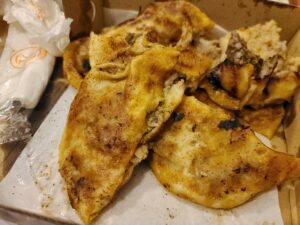
For about $10 USD, we ordered something that looked like (in a photo) a couple of sandwiches, two Cokes and chips. What we received was 5 meaty sandwiches, two Cokes, fries and some kind of meaty bite-sized snacks. One person could easily fill up on fast food for less than the equivalent of $5 USD.
I’m sure there are local fast food chains, but I remain ignorant to these brands. Instead, judge with your eyes. If you see a restaurant that has a lot of people sort of hanging about, perhaps it opens out onto the street, that’s probably a good sign. Give it a shot.
Street Food in Cairo
Street food in Cairo makes for a curious scene. Upon arrival, there didn’t seem to be a lot of street food happening. There are stalls and small shops that open up to the street, but I didn’t see as many vendors cooking and selling food directly on the street as I expected.
As the sun set, I immediately realized what was happening. Cairo is hot, really hot. Not many people want to swelter in the Egyptian sun next to even more heat cooking on the street. After dark, that’s when the city comes to life. Street food included!
From my observations, most of the street eats were on side streets. The large squares and main thoroughfares are apparently not the place to set up shop. As we didn’t wander down any alleys or small roads the first couple of nights, we missed all of the street food.
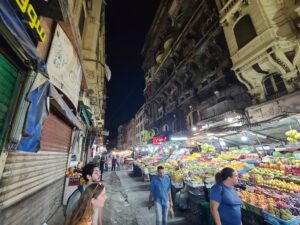
Downtown Cairo has an excellent night time street food scene. Particularly, I found the smaller side streets of the ‘Abdin area to have some excellent street eats. Admittedly, I don’t know what I was always eating, but I certainly enjoyed it.
The areas in which we wandered at night were well-lit and busy. As mentioned in the Hangry Backpacker’s First Impressions of Cairo, we were largely unbothered in Downtown Cairo. Away from the museums, people left us alone. Be smart, but the area felt safe to us.
Food Safety
Since we’ve just finished discussing street food and cheap food, perhaps it’s appropriate to mention food safety. If you’re an adventurous eater like me, you will eat almost anything. I try my best to embrace local food when I travel. There are few opportunities that prove more effective to learn about the culture of your destination than food.
”Food and drink is an open window into another culture.” I’ve said this many, many times over the years. It’s still true.
Anyway, my curious appetite and insatiable desire to explore a destination through food often comes back to bite me. In fact, I think I’ve had food poisoning on 4 different continents, so that’s a fun fact about The Hangry Backpacker.
In the end, despite a few regret-filled and sleepless nights, it has ultimately been worth it. I travel prepared (with appropriate medications) and almost expect some moments of unpleasantness (depending on the destination).
In my experience, Egyptian food isn’t inherently unsafe or dirty. Perhaps an argument can be made about some of the street food being less than ultra-hygienic. For the most part, though, I think food in Egypt is fine.
I can’t accurately comment on the kitchen conditions, so I won’t get into that. However, generally speaking, health codes and food safety is not on the same level we are used to in the United States, Canada and most of Europe.
Our hygienic practices are great for overall safety, but it also leaves us vulnerable when we stray from that food safety bubble. Our guts are not as experienced; hence, the reason so many Americans get sick in Mexico but locals who eat and drink the same things are fine – we’re just not used to it.
All that is to say that eating in Egypt is simply different. Standards are different. And you can never be 100% certain that your silverware, plate or glass is sterilized.
Common sense will get you pretty far. Avoid raw or undercooked food. Choose street food wisely. Stay away from fresh veggies unless you can ensure they’ve been cleaned with CLEAN water.
Make sure you travel prepared (consult a doctor beforehand), but don’t let it scare you from trying new things. Eating in Egypt is both fun and tasty.
“Can I drink the water in Egypt?”
This is probably a question that some people have had to ask. It seems like an obvious answer to me, but I suppose you never know for sure.
Well, the answer is no. Absolutely not. Do not drink the water.
Let me say it once again: Don’t drink the water in Cairo. Don’t drink the water on a Nile River cruise. Don’t drink the water at your fancy Red Sea resort. Do NOT drink the water.
Hopefully, this is clear enough to get the point across.
P.S. Unless you want violent diarrhea with a hearty dose of vomiting, do not drink the water in Egypt.
Drinking Alcohol in Cairo
Drinking in Cairo? In Egypt? Yep.
I, too, expected alcohol to be scarce during my time in Egypt. My presumption was that any drinking in Egypt would largely be confined to resorts. Ignorantly, I completely disregarded the many millions of Christian Copts in the country, for whom consumption of alcohol is accepted. In my defense, I assumed that the Muslim-dominated culture and government would render alcohol a scarcity. This was an incorrect assumption.
To be fair, it’s not as if there are bars to be found on every corner. In fact, bars are scarce. Aside from Western hotels, bars and pubs in Cairo are indeed very few and far between.
That’s okay, though. You don’t travel all the way to Egypt and visit Cairo for the booze. At least I hope not. You’ll surely be disappointed.
That being said, you can still enjoy the occasional drink in Egypt. They even have liquor stores on the streets of Cairo that sell some interesting products.

Here are some tips for consuming alcohol in Cairo:
- Forget about drinking on the street. While alcohol is available, it remains taboo (illegal, to be precise) for a vast majority of the population. Public consumption of alcohol in Cairo is a great way to find yourself in trouble with the law. Getting caught would likely lead to a fine or arrest. Avoid drinking in open areas unless it’s within the grounds of your hotel.
- The amount of options varies significantly across the city. Areas home to larger expat communities, wealthy neighborhoods and more popular tourist areas are your best bet to find a place for a drink.
Neighborhoods in Cairo where you are more likely to find a decent watering hole include Zamalek, Maadi, Heliopolis and Garden City. Downtown Cairo is not the place to go for a splash of booze. There are a few exceptions, such as the Roof Garden. Generally, Downtown Cairo is a great area to visit and explore but not for alcohol. Portions of Cairo that are poorer or lack Westerners will have little-to-no drinking establishments.
Liquor stores are an even rarer sight in Cairo. Much to my surprise, I randomly came across a small liquor store on a corner in Downtown Cairo. It was a simple operation, but I couldn’t resist checking it out. My limited experiences purchasing alcohol in Egypt (outside of bars or restaurants) certainly elicits the feeling that there are prying eyes over your shoulder. Go about your business quietly and quickly – that sums it up.
Cairo is not a boozing destination, and that’s okay. There are other experiences and sights far more interesting than any alcoholic beverage you may find there. If you’re getting the itch, though, and you just want a quiet drink, it’s there.
Prices
Alcohol in Egypt is fairly inexpensive from local shops. It’s not proportional to the cheapness of most things – there is clearly a sin tax applied to purchases – but it largely depends on what you buy.
Foreign brands are more expensive. Everything from Jack Daniels and Johnnie Walker to Grey Goose and Hennessy – you can find these in many of the liquor stores. Although these aren’t on my shopping list at home, the prices were in line with what I expect to see in my local store, equivalent to around $30 USD for a bottle of Jack or Grey Goose.
Local brands are significantly cheaper. The quality, however, varies wildly. For half or even a third of the price of imported brands, it might be worth the risk. And it does make for a fun way to experience something local.
Local Products
After I realized that alcohol isn’t a rarity in Egypt, I was even more surprised to learn that the country produces its own goods. Perhaps my ignorance was shining through, but I genuinely did not expect to find a decent variety of locally produced alcohol in a muslim country.
First, I came across the beer. This was the least surprising. Good beer can be found in Egypt, but the most popular choice and overwhelming favorite is Stella. NOT Stella Artois – just Stella. In fact, this is the original Stella beer, older than the world famous (and highly overrated) Belgian brew. It’s decent for a mass-produced brew.

The sight of Egyptian wine was the biggest surprise. Geographically, it makes sense. Sunshine, dry air and good soil. Those are pretty much the basics for viticulture, right? Either way, I was not expecting to find Egyptian wine. We tried a few varieties, all sourced near Alexandria. It was fine, nothing exceptional, but certainly worth a sampling.
Lastly, there are even local spirits in Egypt. This is where you will find the greatest disparity in quality. Egyptian liquor varies from pretty good to passable to hard-to-drink. My personal favorite is the Champollion brandy. It’s a solid drink. Nothing fancy but decent.
There are several local options from which to sip in Cairo. I recommend trying at least a couple of them. Temper your expectations, but enjoy the chance to get an extra taste of the local experience.
Eating in Cairo is fun. There’s no denying that the cuisine here isn’t on the same level as other, more famous culinary destinations around the world, but it’s not something to ignore during your trip.
The sites of Ancient Egypt are incredible, but the modern country of Egypt today has a lot to offer, too. You can start by sampling the local eats. In a city the size of Cairo, there are going to be more choices than you could try in a lifetime. You have to start somewhere.
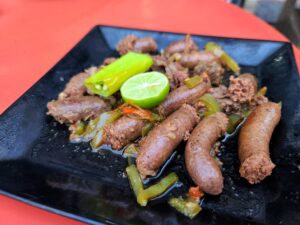
There are few better ways to get a taste of your travel destination than eating, and food is an excellent way to explore Cairo. If you want some extra guidance or reassurance, there are good food tours. Feel free to send us an email about food tours in Cairo, and we’ll send some suggestions your way. If you’re adventurous, I suggest fighting through the language barrier at the first spot that looks good. No matter the method, eating in Cairo is going to be fun.







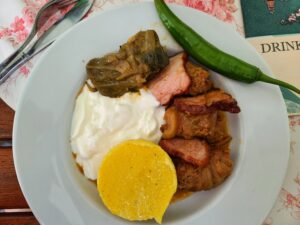
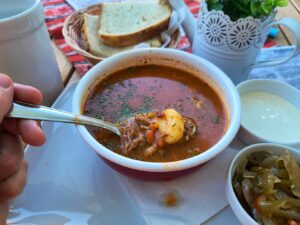


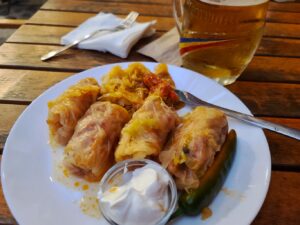









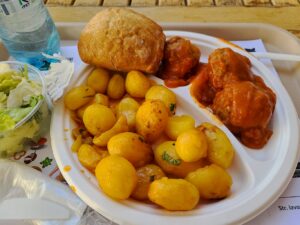

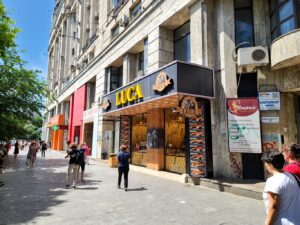
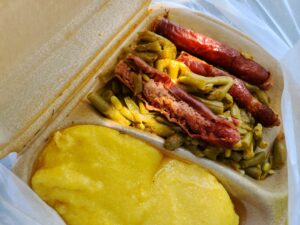













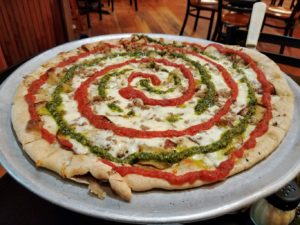












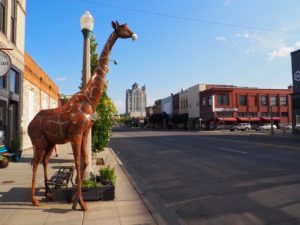











You must be logged in to post a comment.